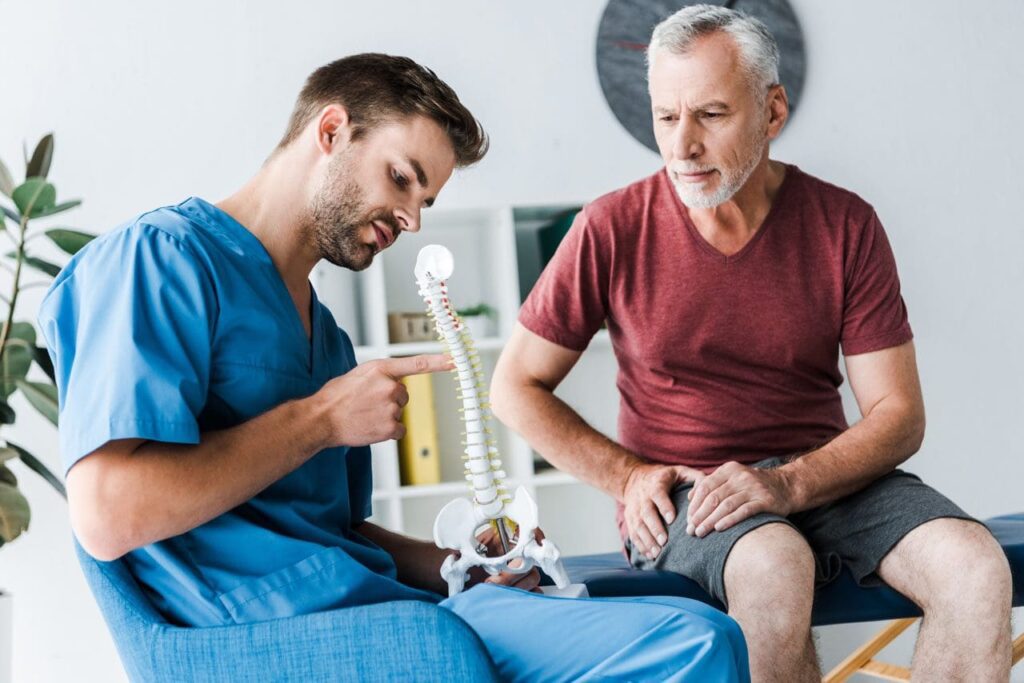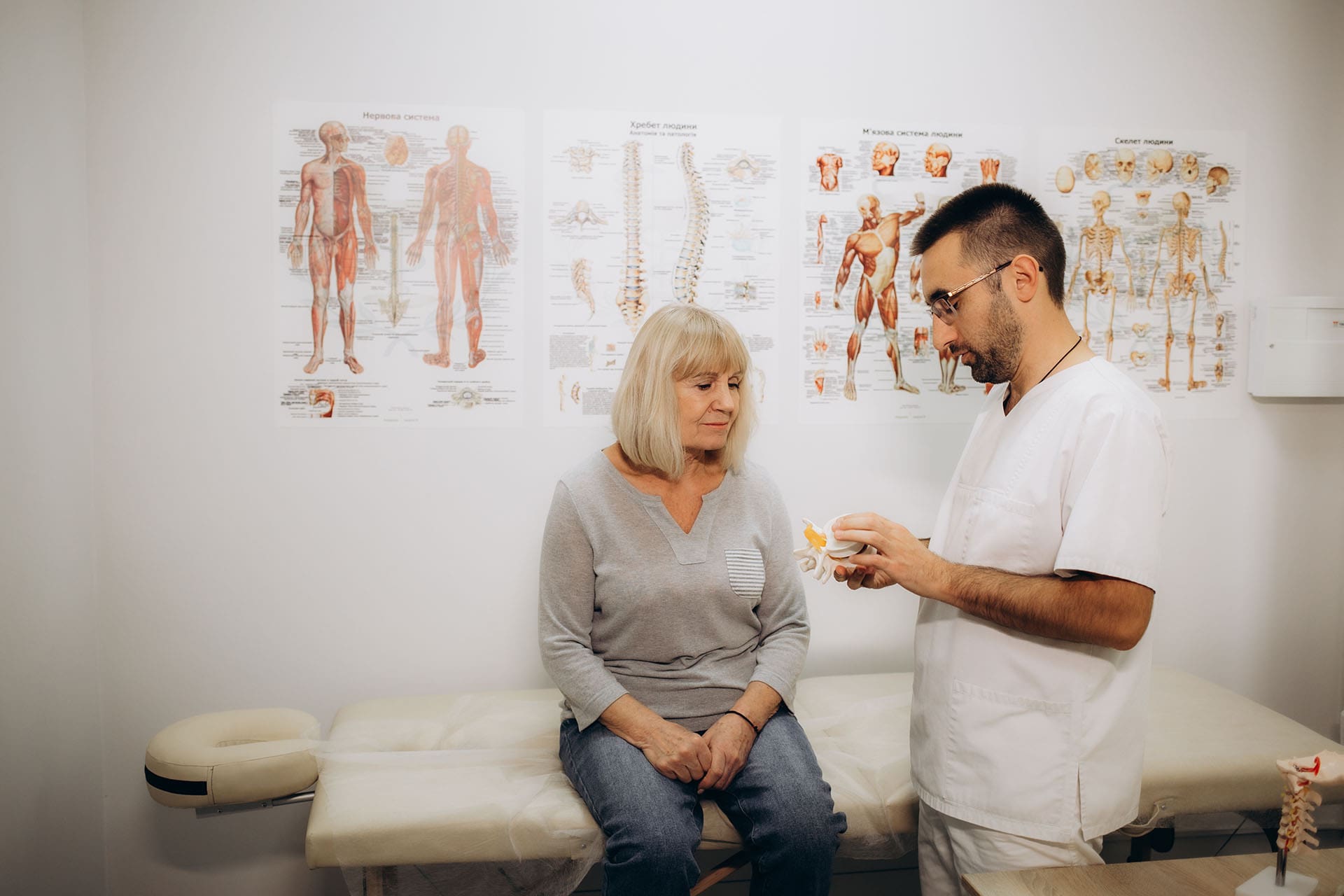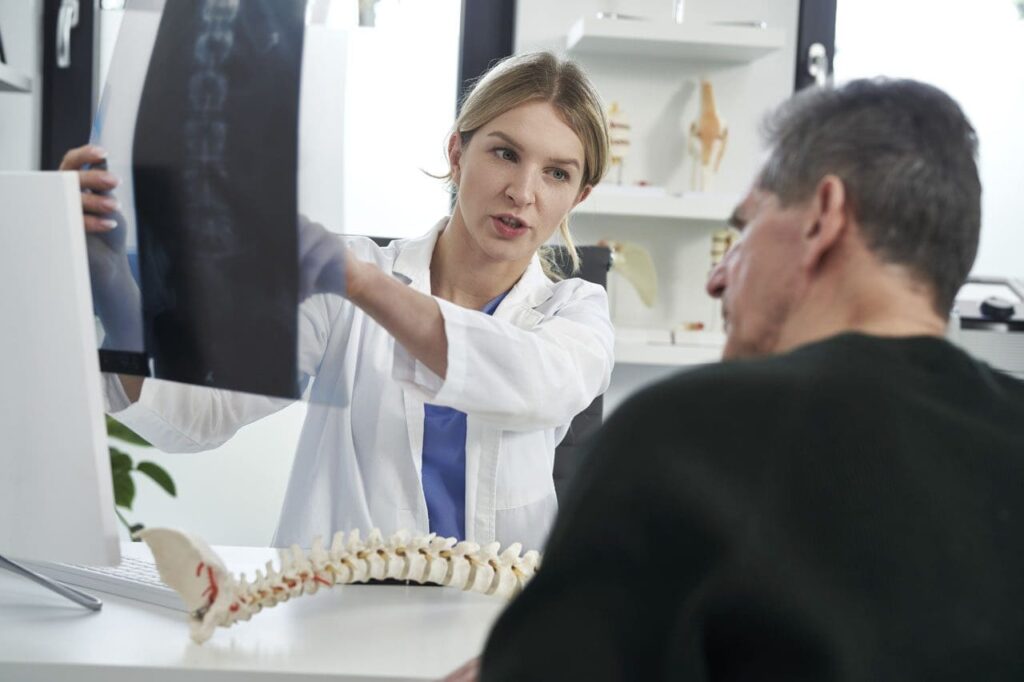Strong Backs with Chiropractic Integrative Care
ChiroMed Back Basics: A Practical, Integrative Guide to Lifelong Spinal Health

What “spinal health” means (straight talk)
Spinal health refers to the proper structure, alignment, and function of your spine, enabling it to support your body, allow for comfortable movement, and protect your spinal cord, which carries nerve signals between your brain and the rest of your body. You can protect your spinal health with regular exercise, good posture, a balanced diet, steady hydration, and a healthy weight. If these habits slip, problems can build into chronic pain, nerve irritation or damage, and a lower quality of life (Raleigh Orthopaedics, 2024; Orthopedic Specialists of SW Florida, 2024; National Spine Health Foundation, 2024). Raleigh Orthopaedic+2SW Florida Orthopedics+2
Why the spine drives whole-body wellness
- Load sharing & alignment. Your spine is the central pillar that keeps you upright and shares loads with the hips and legs; better alignment means less strain everywhere (Premier Spine & Sports Medicine, n.d.). Premier Spine and Sports Medicine
- Movement & shock absorption. Vertebrae, discs, and joints enable you to bend, twist, and absorb impact for daily tasks, work, and sports (Raleigh Orthopaedics, 2024). Raleigh Orthopaedic
- Nerve protection. The spinal canal safeguards nerve tissue; irritation can cause pain, tingling, or weakness that travels into an arm or leg (Cary Orthopaedics, 2023). Cary Orthopaedics
- Quality of life. Unaddressed issues can contribute to fatigue, sleep disturbances, and reduced participation in work or recreational activities (Raleigh Orthopaedics, 2024). Raleigh Orthopaedic
The 3 pillars of a resilient back: Align · Activate · Adapt
1) Align (posture + ergonomics you’ll actually use)
- Sit: feet flat, hips back in the chair, lumbar support, and screen at eye level.
- Stand: weight balanced, knees soft, ears over shoulders.
- Reset every 30–45 minutes—frequent micro-breaks beat one long break (National Spine Health Foundation, 2024). National Spine Health Foundation
Desk quick fix: raise the screen, pull the keyboard/mouse close, and keep forearms supported.
Lifting quick fix: hinge at the hips, brace the core, keep the load close, and exhale as you stand.
2) Activate (movement as daily medicine)
- 20–30 minutes of gentle cardio most days (walking, cycling, swimming).
- Core & hip strength 2–3 days/week: planks, side planks, glute bridges, bird-dogs.
- Mobility after you’re warm: thoracic rotations, hip-flexor and hamstring stretches.
These habits reduce stiffness, support discs and joints, and build endurance for posture (National Spine Health Foundation, 2024; Mobility Project PT, 2024). National Spine Health Foundation+1
3) Adapt (recovery, stress, sleep)
- Sleep neutral: a mattress and pillow that keep your neck/back aligned. Side sleepers: pillow between knees; back sleepers: pillow under knees.
- Downshift stress: taking a 3–5 minute breathing break or going for a short walk can help lower tension, which often reduces pain sensitivity (Raleigh Orthopaedics, 2024). Raleigh Orthopaedic
Common spinal problems—and how conservative care helps
- Strains/sprains and facet irritation from long sitting or awkward lifting
- Disc issues that can irritate nearby nerves and trigger radiating symptoms
- Spinal stenosis (narrowing) that can pinch nerves
- Degenerative changes are tied to inactivity, smoking, or excess body weight
Most cases improve with movement, posture resets, targeted exercises, and load management—especially when treatment begins early (Orthopedic Specialists of SW Florida, 2024). SW Florida Orthopedics
Red flags—don’t wait: radiating pain, numbness, weakness, headaches, or loss of function. Get a timely exam (Cary Orthopaedics, 2023; Suarez Physical Therapy, n.d.). Cary Orthopaedics+1
The ChiroMed-style conservative care playbook (evidence-informed & integrative)
An integrative chiropractic setting typically combines:
- Chiropractic adjustments to restore motion and reduce joint irritation
- Exercise therapy for core/hip strength and mobility
- Manual therapy/massage for tight or sensitive tissues
- Acupuncture when appropriate
- Education on ergonomics, lifting, sleep, and self-care routines
(Prestige Health & Wellness, n.d.; Mobility Project PT, 2024; Raleigh Orthopaedics, 2024). Prestige Health and Wellness+2Mobility Project Physical Therapy+2
If red flags or stubborn neurological signs are present, your provider may order imaging to clarify the diagnosis and guide next steps (Cary Orthopaedics, 2023). Cary Orthopaedics
Fuel your spine: simple nutrition that works
- Protein (muscle/ligament repair)
- Omega-3 fats (help moderate inflammation)
- Calcium + Vitamin D (bone strength)
- Magnesium (nerve and muscle function)
- Colorful fruits & vegetables (antioxidants for recovery)
- Water (disc hydration and nutrient transport)
These basics support tissue healing and resilience (Watkins Family Chiropractic, n.d.; Orthopedic Specialists of SW Florida, 2024). Watkins Family Chiropractic+1
Hydration matters: steady water intake helps keep discs “springy,” and pairing hydration with a healthy body weight reduces stress on joints and discs (Centeno-Schultz Clinic, n.d.; Raleigh Orthopaedics, 2024). Centeno-Schultz Clinic+1
Two environments, two quick setups
Office/Remote work
- Position the screen at eye level, with lumbar support or a small pillow, and your arms close to your sides.
- Stand-up breaks or a 60-second walk every 30–45 minutes (NSHF, 2024). National Spine Health Foundation
Physical jobs
- Practice the hip hinge with light objects daily to improve your flexibility.
- Rotate tasks when possible and use brief mobility breaks to reset your posture.
Sport, driving, and travel: keep momentum
- Sport: pair mobility + core/hip strength; return to play gradually.
- Driving: the seat is close enough for slightly bent knees; the headrest is aligned with the back of the head; posture is checked at stops.
- Travel: micro-moves every fuel or restroom break (NSHF, 2024; Centeno-Schultz Clinic, n.d.). National Spine Health Foundation+1
The 4-week “Momentum Map” (minimal gear, steady progress)
Week 1 — Build the base
- Daily: 10-minute walk + 5 minutes mobility (open-books, hip-flexor, hamstrings).
- Core (3×/week): plank 20 s, side plank 15 s/side, glute bridge 10 reps.
- Posture: Raise the screen and add a small lumbar roll.
Week 2 — Add consistency
- Daily: 15–20 minutes walk/cycle + mobility.
- Core (3×/week): plank 25–30 s, side plank 20 s/side, bridge 12 reps; add bird-dog 6/side.
- Nutrition nudge: leafy greens + lean protein at each meal (Watkins Family Chiropractic, n.d.). Watkins Family Chiropractic
Week 3 — Strength + recovery
- Cardio most days: 20–25 minutes.
- Light hinge pattern 1–2×/week (backpack or kettlebell) with the load close.
- Pre-bed slow breathing for 3–5 minutes (Raleigh Orthopaedics, 2024). Raleigh Orthopaedic
Week 4 — Re-test & refine
- Repeat day-one moves and note changes in pain, flexibility, and energy.
- Keep what helps, trim what doesn’t.
- If numbness, weakness, or radiating pain persists, schedule an exam (Cary Orthopaedics, 2023; Suarez Physical Therapy, n.d.). Cary Orthopaedics+1
Myths vs. facts (clinic edition)
- Myth: “If my back hurts, I should rest all day.”
Fact: Gentle movement and short walks often speed recovery; long bed rest increases stiffness (National Spine Health Foundation, 2024). National Spine Health Foundation - Myth: “Only heavy lifting causes back pain.”
Fact: Prolonged sitting, poor ergonomics, stress, and sleep problems also drive pain (NSHF, 2024; Raleigh Orthopaedics, 2024). National Spine Health Foundation+1
When to see a clinician (simple rule)
- New or worsening radiating pain, numbness/weakness, or loss of function
- Night pain, fever, or unexplained weight loss
- Pain that persists beyond a couple of weeks despite basic steps
These are reasons for prompt evaluation and, if indicated, imaging to guide care (Cary Orthopaedics, 2023; Orthopedic Specialists of SW Florida, 2024). Cary Orthopaedics+1
References
- Cary Orthopaedics. (2023, September 7). [Spine FAQs]. https://www.caryortho.com/spine-center/spine-faqs/ Cary Orthopaedics
- Centeno-Schultz Clinic. (n.d.). [Thoracic and lumbar spine—All you need to know]. https://centenoschultz.com/understanding-the-thoracic-and-lumbar-spines/ Centeno-Schultz Clinic
- Mobility Project Physical Therapy. (2024, September 20). [The importance of spinal health and how to maintain it]. https://mobilityprojectpt.com/the-importance-of-spinal-health-and-how-to-maintain-it/ Mobility Project Physical Therapy
- National Spine Health Foundation. (2024, October 17). [30 tips for spine health prevention & wellness]. https://spinehealth.org/article/spine-health-wellness/ National Spine Health Foundation
- Orthopedic Specialists of Southwest Florida. (2024, June 13; updated August 22). [Spinal health 101: Prevention and treatment of common disorders]. https://www.osswf.com/spinal-health-101-prevention-and-treatment-of-common-disorders/ SW Florida Orthopedics
- Premier Spine & Sports Medicine. (n.d.). [The backbone of wellness: Nurturing your spinal health]. https://premierspineandsports.com/the-backbone-of-wellness-nurturing-your-spinal-health/ Premier Spine and Sports Medicine
- Raleigh Orthopaedics. (2024, August 6). [Why spine health is essential for your overall wellness]. https://www.raleighortho.com/blog/neck-and-back/why-spine-health-is-essential-for-your-overall-wellness/ Raleigh Orthopaedic
- Suarez Physical Therapy. (n.d.). [Low back pain]. https://www.suarezpt.com/services/symptoms-conditions/low-back-pain Suarez Physical Therapy
- Watkins Family Chiropractic. (n.d.). [Nutrition and spinal health: The vital connection]. https://www.watkinsfamilychiropractic.com/nutrition-and-spinal-health-the-vital-connection/ Watkins Family Chiropractic



